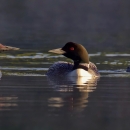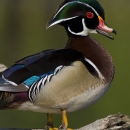Seasons of Wildlife
From December to February, the refuge has many resident species including white-tailed deer, red fox, ruffed grouse, white-breasted nuthatch and downy woodpecker. Many of these species can be seen from the visitor center and trails.
Spring migration is in full swing in April and May, with up to 100 species seen in a day from the trails on the refuge. Snow geese, tundra swans, northern pintails and prairie falcons are passing through. Trumpeter swans, wood ducks, red-tailed hawks, eastern bluebirds, yellow warblers and red-winged blackbirds are returning to nest.
The refuge is full of wildlife families from June to July. Songbird and raptor nests are located along the trails. Mallard, wood duck, hooded merganser, Canada goose and trumpeter swan broods are visible on the wetlands. White-tailed deer fawns appear in the prairie.
The southward migration of waterfowl and songbirds occurs in September and October, with thousands of waterfowl gathering on refuge wetlands and lakes. Resident wildlife, such as black bear, ruffed grouse and white-tailed deer, are feeding heavily to store fat for the winter.
Featured Species
The refuge has diverse habitats that support a variety of wildlife species. Waterfowl, including ducks, geese and swans, rely on the wetlands and the surrounding grasslands and woodlands for feeding and nesting. Trumpeter swans, the largest of North American waterfowl, nest here each year. Bald eagles and osprey hunt on the refuge and gray wolves are occasionally seen. Resident species include white-tailed deer, black bear, ruffed grouse, great horned owl, pileated woodpecker, long-tailed weasel, red fox, river otter and beaver.












